By Leen Randell
Updated: Jul 08, 2024
10 Best Herbal Tinctures For Nausea
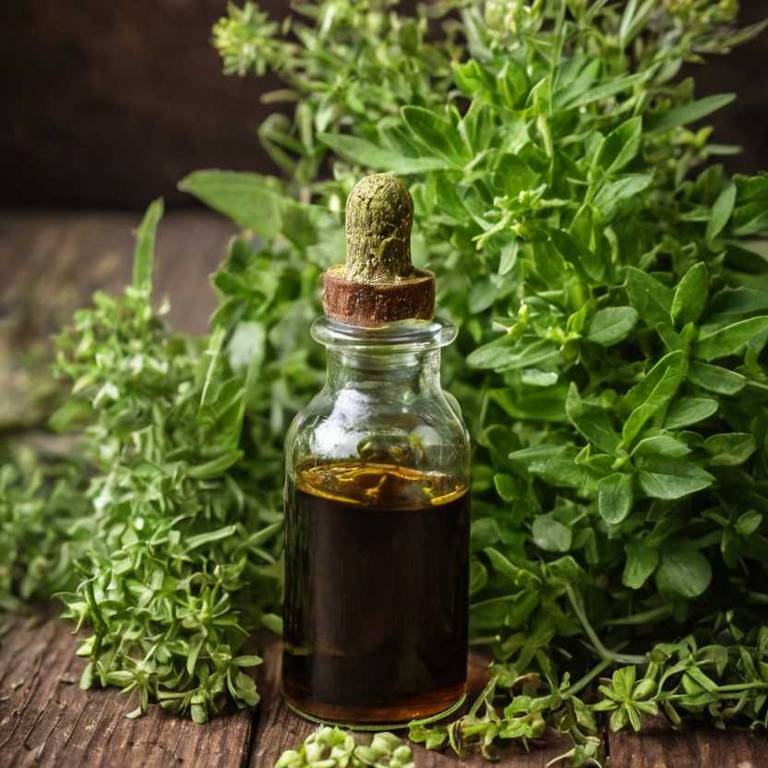
Herbal tinctures for nausea are concentrated liquid extracts made from plants, used to alleviate symptoms of nausea, vomiting, and digestive discomfort.
These natural remedies help by calming the stomach, reducing inflammation, and promoting relaxation. Examples include ginger, peppermint, and lemon balm tinctures, which have been used for centuries to soothe stomach issues. For instance, a woman who suffers from morning sickness during pregnancy can benefit from taking ginger tincture before meals, improving her appetite and overall well-being.
This natural approach empowers individuals to take control of their digestive health and regain confidence in their daily lives.
The following article describes in detail the most important tinctures for nausea, including medicinal properties, parts of herbs to use, and recipes for preparations.
- 1. Zingiber officinale
- 2. Mentha x piperita
- 3. Matricaria chamomilla
- 4. Taraxacum officinale
- 5. Melissa officinalis
- 6. Ginkgo biloba
- 7. Curcuma longa
- 8. Foeniculum vulgare
- 9. Glycyrrhiza glabra
- 10. Pimpinella anisum
- What is the best combination of herbal tinctures to use for nausea?
- What ailments similar to nausea are treated with herbal tinctures?
1. Zingiber officinale
Ginger tinctures helps with nausea because of its unique ability to interact with the digestive system.
The bioactive compounds present in ginger, such as gingerols and shogaols, have natural anti-inflammatory properties that help to reduce inflammation and alleviate symptoms associated with nausea, including stomach discomfort and bloating.
Additionally, ginger's warming properties help to stimulate digestion and relieve feelings of queasiness, providing quick relief from nausea caused by various triggers, including motion sickness, morning sickness during pregnancy, or food poisoning.

Medicinal Constituents
The list below shows the primary medicinal constituents in Zingiber officinale tinctures that help with nausea.
- Gingerols: These sesquiterpenoids have anti-inflammatory and antiemetic properties, helping to reduce nausea by inhibiting the release of stomach acid and improving digestion.
- Shogaols: These vanilllyl compounds have anti-inflammatory and antioxidant properties, contributing to their antiemetic effects by reducing inflammation in the stomach and intestines, which can help alleviate nausea.
- Zingerone: This vanillyl compound has anti-inflammatory and antioxidant properties, which may help to reduce nausea by inhibiting the production of stomach acid and improving digestion, as well as by reducing inflammation in the stomach and intestines.
Parts Used
The list below shows the primary parts of ginger used to make tinctures for nausea.
- Rhyzomes: The rhizomes are the most commonly used part of ginger due to their high concentration of active compounds, particularly gingerols and shogaols, which are responsible for its anti-inflammatory and anti-emetic effects.
- Roots: The roots of ginger also contain the active compounds responsible for its nausea-relieving properties, making them a popular choice for tincture production.
- Stems: Although less commonly used, ginger stems also contain the active compounds and have been traditionally used in some herbal remedies to help alleviate nausea.
Quick Recipe
The following recipe gives a procedure to make a basic ginger for nausea.
- Harvest fresh zingiber officinale rhizomes in the morning when they are at their highest moisture content.
- Slice the rhizomes thinly using a sharp knife to increase their surface area for infusion.
- Combine 100 grams of sliced zingiber officinale with 500 milliliters of 80 proof vodka in a clean glass jar.
- Store the mixture in a cool dark place for six to eight weeks to allow for extraction.
- Strain the liquid through a cheesecloth into another clean glass bottle discarding the solids completely.
2. Mentha x piperita
Peppermint tinctures helps with nausea because of its unique ability to calm the digestive system.
The menthol content in peppermint oil relaxes the stomach muscles, reducing inflammation and spasms that can contribute to queasiness. Additionally, peppermint's natural anti-inflammatory properties help to reduce gut irritation and soothe the stomach lining, further alleviating nausea symptoms.
By calming the digestive tract, peppermint tinctures can provide quick and effective relief from nausea and vomiting, making it a popular natural remedy for morning sickness and other stomach woes.

Medicinal Constituents
The list below shows the primary medicinal constituents in Mentha x piperita tinctures that help with nausea.
- Piperitone: Piperitone, a monoterpenic ketone, helps alleviate nausea by acting as a natural anti-inflammatory and antispasmodic agent, reducing stomach cramps and discomfort.
- Menthol: Menthol, a volatile monoterpenic alcohol, helps with nausea by numbing the stomach and reducing inflammation, thereby decreasing the sensation of nausea.
- Roscavin: Roscavin, a phenolic compound, helps alleviate nausea by modulating the gut-brain axis and reducing inflammation in the gastrointestinal tract, thus alleviating nausea and vomiting.
Parts Used
The list below shows the primary parts of peppermint used to make tinctures for nausea.
- Leaves: The leaves of Mentha x piperita are widely used to make tinctures for nausea due to their high concentration of menthol and menthone, which have anti-inflammatory and calming properties.
- Stems: The stems of Mentha x piperita are sometimes used to make tinctures for nausea, as they contain oils that help to soothe the digestive system and alleviate symptoms of nausea.
- Roots: The roots of Mentha x piperita are occasionally used to make tinctures for nausea, as they contain menthol and other compounds that have anti-inflammatory properties and may help to reduce nausea and vomiting.
Quick Recipe
The following recipe gives a procedure to make a basic peppermint for nausea.
- Harvest 100g of fresh mentha x piperita leaves and flowers at peak potency in the morning.
- Clean and dry the harvested plant material at room temperature for 7 days to prevent contamination.
- Combine the dried plant material with 500ml of 95% ethanol in a clean glass jar.
- Steep the mixture in a cool dark place for 2 weeks with occasional shaking to facilitate extraction.
- Strain and filter the tincture through cheesecloth into a clean glass bottle for storage.
3. Matricaria chamomilla
Chamomile tinctures helps with nausea because its calming properties soothe the stomach and reduce inflammation.
The herb's apigenin content has been shown to bind to benzodiazepine receptors, promoting relaxation and reducing anxiety-induced nausea. Additionally, chamomile's anti-inflammatory compounds help alleviate digestive discomfort and ease cramps, providing swift relief from nausea and vomiting.
As a natural and gentle remedy, chamomile tinctures offer a safe and effective way to find fast relief from queasy feelings.
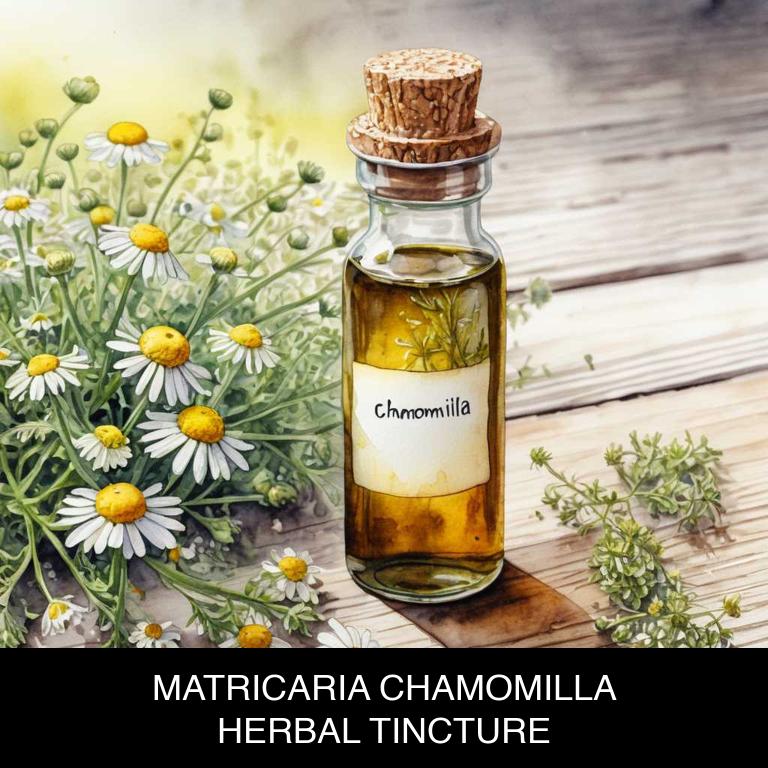
Medicinal Constituents
The list below shows the primary medicinal constituents in Matricaria chamomilla tinctures that help with nausea.
- Apigenin: A flavonoid with anti-inflammatory properties, apigenin helps alleviate nausea by reducing inflammation in the digestive tract and promoting relaxation.
- Luteolin: A flavone with antioxidant properties, luteolin helps combat nausea by neutralizing free radicals and stabilizing the gut microbiome to prevent digestive discomfort.
- Α-bisabolol: A sesquiterpene with anti-inflammatory and soothing properties, α-bisabolol helps ease nausea by calming the digestive system, reducing inflammation, and promoting a sense of relaxation.
Parts Used
The list below shows the primary parts of chamomile used to make tinctures for nausea.
- Flowers: They are used because of their high concentration of apigenin and luteolin, which have anti-inflammatory and calming effects that help alleviate nausea.
- Seeds: They are used because they contain a higher concentration of essential oils than the flowers, providing a more potent anti-inflammatory effect against nausea.
- Leaves: They are used because they have a more subtle effect than the flowers or seeds, providing a gentle, calming influence that can help reduce nausea.
Quick Recipe
The following recipe gives a procedure to make a basic chamomile for nausea.
- Harvest fresh matricaria chamomilla flowers in the morning after the dew has evaporated to ensure optimal potency.
- Dry the harvested matricaria chamomilla flowers in a low-temperature oven at 105°f for 2 hours to preserve quality.
- Combine 1 part dried matricaria chamomilla flowers with 2 parts vodka in a clean glass jar to create the tincture base.
- Store the jar in a cool dark place for 2-6 weeks shaking it every day to facilitate extraction.
- Strain the tincture through a cheesecloth or coffee filter into a clean glass bottle discarding the solids.
4. Taraxacum officinale
Dandelion tinctures helps with nausea because of its natural anti-inflammatory properties, which soothe and calm the stomach lining.
The tincture's bitter compounds also stimulate digestive enzymes and help to reduce inflammation in the gut, alleviating symptoms of nausea and vomiting. Additionally, dandelion's high concentration of antioxidants protects the stomach from oxidative stress, further reducing inflammation and promoting overall gut health.
This natural remedy provides a gentle and effective way to alleviate nausea and promote a healthy digestive system.
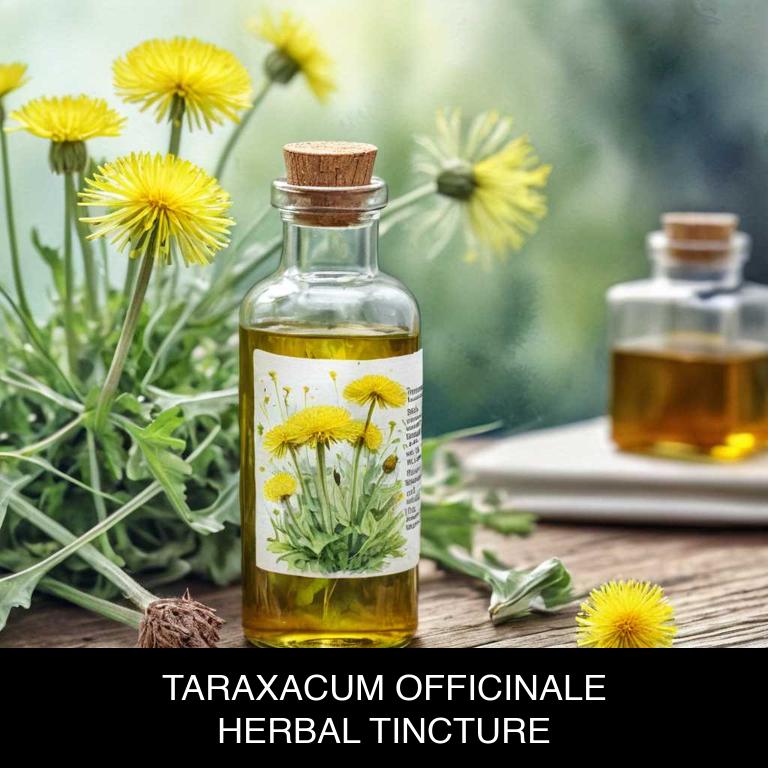
Medicinal Constituents
The list below shows the primary medicinal constituents in Taraxacum officinale tinctures that help with nausea.
- Flavonoids: These plant-derived compounds help alleviate nausea by exhibiting anti-inflammatory and antioxidant properties, which can reduce the severity of nausea and vomiting.
- Phenolic acids: These acids have been shown to have anti-inflammatory and antioxidant effects, which can help mitigate nausea and vomiting by reducing inflammation and oxidative stress in the gut.
- Taraxasterol: This compound may help alleviate nausea by exhibiting anti-inflammatory and protective effects on the gastrointestinal tract, which can help reduce inflammation and discomfort associated with nausea and vomiting.
Parts Used
The list below shows the primary parts of dandelion used to make tinctures for nausea.
- Leaves: They are commonly used in tinctures to help alleviate nausea due to their bitter and astringent properties.
- Flowers: Taraxacum officinale flowers are used to make tinctures to help soothe digestive issues and alleviate nausea, primarily due to their anti-inflammatory properties.
- Roots: The roots of Taraxacum officinale are used in tinctures to help calm digestive issues and alleviate nausea, thanks to their bitter compounds and potential anti-inflammatory effects.
Quick Recipe
The following recipe gives a procedure to make a basic dandelion for nausea.
- Harvest 1 part of the fresh dandelion roots and 2 parts of the leaves on a dry sunny morning.
- Dry the harvested plant material in a single layer on paper bags at 50 degrees celsius for 2 hours.
- Combine 1 part of the dried plant material with 2 parts of 80 proof vodka in a clean glass jar.
- Steep the mixture in a cool dark place for 2 to 4 weeks shaking the jar every week.
- Strain the liquid through a coffee filter into a clean glass bottle and discard the solids.
5. Melissa officinalis
Lemon balm tinctures helps with nausea because of its natural ability to calm the stomach and alleviate digestive discomfort.
The herb contains rosmarinic acid, which has anti-inflammatory properties that can help soothe an upset stomach and reduce symptoms of nausea. Additionally, lemon balm's sweet, citrusy flavor can be very comforting and relaxing, making it an effective remedy for those experiencing morning sickness or post-operative nausea.
By reducing anxiety and calming the digestive system, herbal lemon balm tinctures can provide quick relief from nausea and promote a sense of well-being.
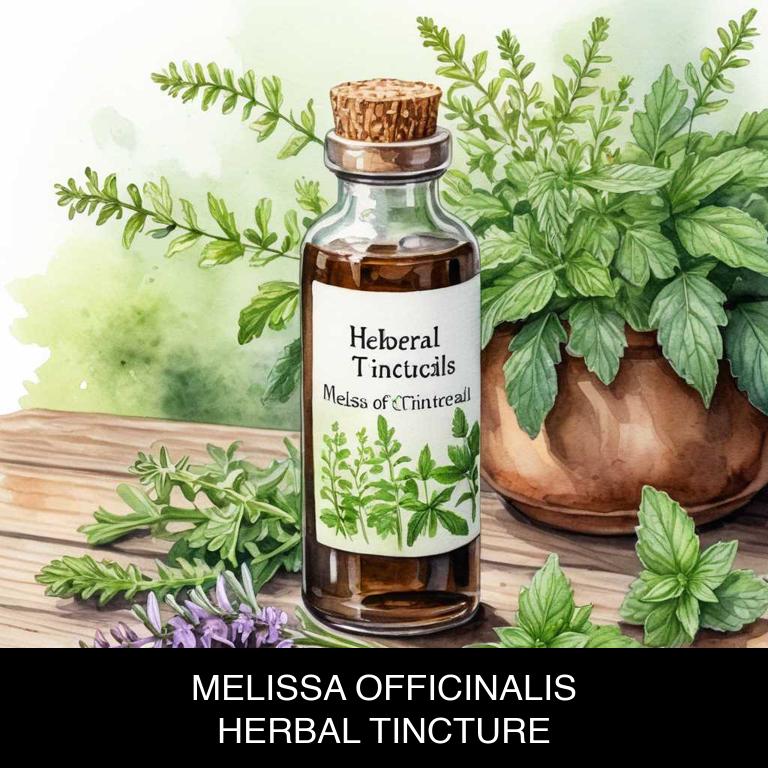
Medicinal Constituents
The list below shows the primary medicinal constituents in Melissa officinalis tinctures that help with nausea.
- Rosmarinic acid: A phenolic compound that has antioxidant and anti-inflammatory properties, which can help to reduce nausea by inhibiting the release of pro-inflammatory mediators.
- Linalool: A terpene that has a sedative and anti-emetic effect, which can help to calm the stomach and reduce nausea.
- Volatile oils: Terpenes that have anti-inflammatory and anxiolytic properties, which can help to reduce nausea by reducing stress and anxiety.
Parts Used
The list below shows the primary parts of lemon balm used to make tinctures for nausea.
- Leaves: They are the primary source due to their high concentration of essential oils, which contain compounds like linalool and linalyl acetate, known for their calming and anti-nausea effects.
- Flowers: The flowers are also used because they have a higher concentration of linalool and other essential oils, which contribute to their soothing properties and ability to alleviate nausea.
- Stems: The stems of Melissa officinalis contain a significant amount of the same essential oils as the leaves and flowers, making them a viable alternative or complementary part for tincture production.
Quick Recipe
The following recipe gives a procedure to make a basic lemon balm for nausea.
- Harvest fresh melissa officinalis leaves and flowers when they are in full bloom for maximum potency.
- Chop 500 grams of the harvested melissa officinalis plant material into small pieces to increase surface area.
- Combine the chopped melissa officinalis with 500 milliliters of 80 percent ethanol in a clean glass jar.
- Steep the mixture for 2 weeks in a cool dark place with occasional shaking to ensure extraction.
- Strain the liquid through a cheesecloth or a fine-mesh sieve into a clean glass container.
6. Ginkgo biloba
Maidenhair tree tinctures helps with nausea because of its unique composition, which includes flavonoids, phenolic acids, and other bioactive compounds.
These compounds have been shown to exhibit anti-inflammatory and antioxidant properties, which can help soothe the stomach and reduce nausea symptoms. The tincture's ability to calm digestive issues may also be attributed to its gentle sedative effects on the nervous system, allowing it to regulate digestive rhythms and alleviate feelings of queasiness.
As a result, maidenhair tree tinctures have been traditionally used to alleviate morning sickness, travel-induced nausea, and other forms of nausea-related discomfort.

Medicinal Constituents
The list below shows the primary medicinal constituents in Ginkgo biloba tinctures that help with nausea.
- Bilobalide: Bilobalide has anti-inflammatory and antioxidant properties, which can help alleviate nausea by reducing inflammation and oxidative stress in the gastrointestinal tract.
- Flavonoids: Flavonoids in Ginkgo biloba have anti-inflammatory and antioxidant effects, which can help alleviate nausea by reducing inflammation and oxidative stress in the gastrointestinal tract.
- Ginkgolides: Ginkgolides have anti-inflammatory properties, which can help alleviate nausea by reducing inflammation in the gastrointestinal tract and promoting the release of serotonin, a neurotransmitter that helps regulate nausea.
Parts Used
The list below shows the primary parts of maidenhair tree used to make tinctures for nausea.
- Leaves: They are the most commonly used part of the Ginkgo biloba plant for medicinal purposes, including the treatment of nausea.
- Seeds: Ginkgo biloba seeds are known to have anti-inflammatory properties, which can help alleviate nausea.
- Roots: Ginkgo biloba roots are believed to have a soothing effect on the stomach, which can help reduce nausea.
Quick Recipe
The following recipe gives a procedure to make a basic maidenhair tree for nausea.
- Harvest 1-2 cups of fresh or dried ginkgo biloba leaves and flowers in late summer or early fall.
- Chop the ginkgo biloba leaves and flowers into small pieces using a sharp knife or herb cutter.
- Combine 1 part chopped ginkgo biloba with 2 parts 80-proof vodka in a clean glass jar.
- Steep the mixture in a cool dark place for 2-4 weeks, shaking the jar daily.
- Strain the liquid through a cheesecloth or a coffee filter into a clean glass bottle and discard the solids.
7. Curcuma longa
Turmeric tinctures helps with nausea because of its unique composition, which includes curcuminoids that have potent anti-inflammatory and antioxidant properties.
When taken as a supplement, these compounds work to reduce inflammation in the digestive tract, alleviating symptoms of nausea and discomfort.
Additionally, turmeric's natural ability to soothe and calm the stomach helps to ease queasiness and reduce the frequency and severity of nausea episodes.

Medicinal Constituents
The list below shows the primary medicinal constituents in Curcuma longa tinctures that help with nausea.
- Curcumin: This polyphenolic compound has anti-inflammatory and antioxidant properties, which help reduce inflammation and irritation in the stomach, alleviating nausea and vomiting.
- Demethoxycurcumin: As a bioactive compound, DMC has been shown to inhibit the growth of bacteria and other pathogens that can cause gastrointestinal issues, including nausea, by promoting a healthy gut microbiome.
- Volatile oils: These terpenic compounds have anti-inflammatory and antioxidant properties, which help reduce inflammation and irritation in the stomach, alleviating nausea and vomiting.
Parts Used
The list below shows the primary parts of turmeric used to make tinctures for nausea.
- Roots: The roots of Curcuma longa also contain curcumin and other active compounds that help alleviate nausea and other digestive issues.
- Stems: Some herbal remedies use the stems of Curcuma longa to make tinctures for nausea, as they contain a smaller amount of curcumin compared to the rhyzome, but still possess some medicinal properties.
Quick Recipe
The following recipe gives a procedure to make a basic turmeric for nausea.
- Harvest curcuma longa roots in late summer or early fall when they are mature and dry.
- Chop the roots into small pieces to increase their surface area for extraction.
- Mix 100 grams of the chopped roots with 500 milliliters of 80 proof ethanol in a clean glass jar.
- Steep the mixture in a cool dark place for 2 to 3 weeks to allow for extraction.
- Strain the liquid through a cheesecloth or a coffee filter into a clean glass bottle.
8. Foeniculum vulgare
Fennel tinctures helps with nausea because it contains a natural compound called anethole, which has been shown to have anti-inflammatory properties that can help soothe the digestive system and reduce symptoms of nausea.
When taken as a supplement or added to food and drinks, fennel tincture may help calm upset stomachs and alleviate feelings of queasiness, making it a popular natural remedy for morning sickness, motion sickness, and other forms of nausea.

Medicinal Constituents
The list below shows the primary medicinal constituents in Foeniculum vulgare tinctures that help with nausea.
- Anethole: Anethole, a primary terpene in Foeniculum vulgare, helps alleviate nausea by inhibiting the contractions of the smooth muscle in the stomach, thereby reducing spasms and discomfort.
- Foeniculin: Foeniculin, a sesquiterpene lactone, is known to have anti-inflammatory properties, which can contribute to its anti-nausea effects by reducing inflammation in the digestive tract and alleviating symptoms.
- Apigenin: Apigenin, a flavonoid phenolic compound, has been found to have anti-emetic properties, which help reduce nausea and vomiting by inhibiting the action of neurotransmitters involved in the nausea response.
Parts Used
The list below shows the primary parts of fennel used to make tinctures for nausea.
- Seeds: They are commonly used to make tinctures for nausea due to their high concentration of volatile oils, particularly anethole, which has anti-inflammatory and carminative properties.
- Leaves: Fennel leaves are used to make tinctures for nausea as they contain flavonoids and phenolic acids that have anti-inflammatory and antioxidant properties, which help alleviate nausea and other digestive issues.
- Barks: Fennel barks are sometimes used to make tinctures for nausea, possibly due to their high concentration of phenolic compounds and flavonoids that have anti-inflammatory and antioxidant properties, which may help soothe digestive issues and reduce nausea.
Quick Recipe
The following recipe gives a procedure to make a basic fennel for nausea.
- Harvest 1 part of dried foeniculum vulgare leaves and flowers in the morning when the dew is still present.
- Chop the harvested foeniculum vulgare into small pieces to increase its surface area for extraction.
- Combine the chopped foeniculum vulgare with 2 parts of 80-proof vodka in a clean glass jar.
- Seal the jar and place it in a cool dark cupboard for 4 to 6 weeks to allow the extraction process to occur.
- Strain the liquid through a cheesecloth or coffee filter into another clean glass jar to obtain the foeniculum vulgare tincture.
9. Glycyrrhiza glabra
Licorice tinctures helps with nausea because it contains compounds that have a soothing effect on the digestive system.
Glycyrrhizin, a key component of licorice root, has been shown to reduce inflammation and irritation in the stomach and intestines, which can help alleviate symptoms of nausea. Additionally, licorice tincture's expectorant properties can help calm the stomach and promote digestion, further reducing the occurrence of nausea.
By addressing the underlying causes of nausea, herbal licorice tinctures provide natural relief from this uncomfortable condition.
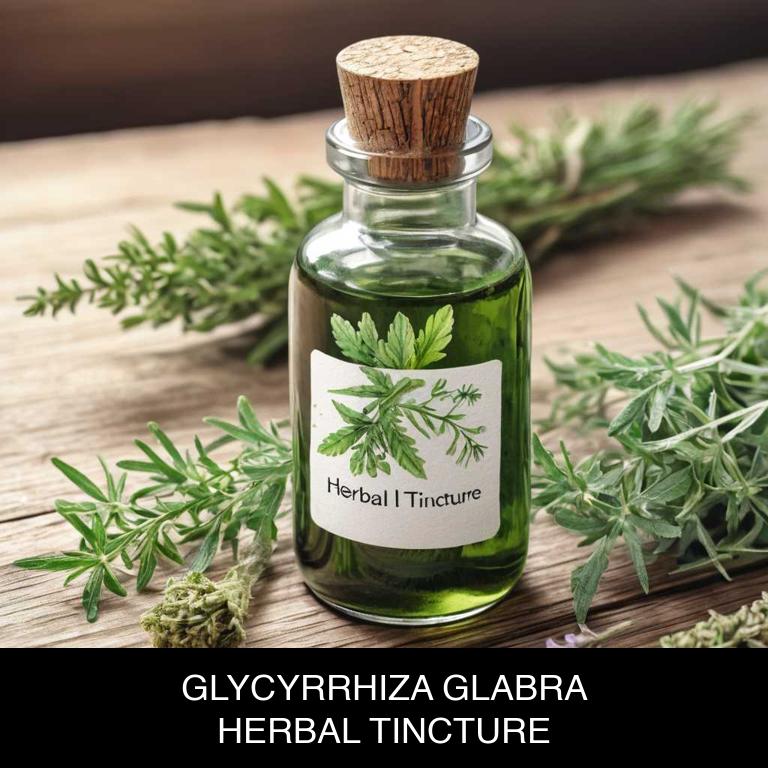
Medicinal Constituents
The list below shows the primary medicinal constituents in Glycyrrhiza glabra tinctures that help with nausea.
- Glycyrrhizin: Glycyrrhizin is an effective anti-inflammatory triterpene that helps reduce nausea by modulating the immune system and alleviating inflammation in the digestive tract.
- Liquiritigenin: Liquiritigenin is a flavonoid with anti-inflammatory and antioxidant properties that helps alleviate nausea by reducing inflammation, oxidative stress, and modulating the gut-brain axis.
- Isoliquiritigenin: Isoliquiritigenin is a flavonoid that has been shown to exhibit anti-inflammatory and anti-emetic (nausea-reducing) effects by modulating the gut-brain axis, reducing inflammation, and alleviating gastrointestinal disorders.
Parts Used
The list below shows the primary parts of licorice used to make tinctures for nausea.
- Roots: The roots of Glycyrrhiza glabra are commonly used to make tinctures for nausea due to their high concentration of glycyrrhizin, a compound that has anti-inflammatory and anti-emetic properties.
- Leaves: The leaves are used to make tinctures for nausea as they contain flavonoids and saponins that have been shown to have anti-inflammatory and anti-nausea effects.
- Barks: The barks are used to make tinctures for nausea due to their content of glycosides and phenolic compounds that have been demonstrated to possess anti-inflammatory and anti-emetic properties.
Quick Recipe
The following recipe gives a procedure to make a basic licorice for nausea.
- Harvest 1 part of glycyrrhiza glabra roots in the autumn season when the plant is mature and the roots are fully developed.
- Cut the roots into small pieces to increase the surface area for the extraction process.
- Combine the 1 part glycyrrhiza glabra roots with 2 parts of 95% ethanol in a glass container.
- Steep the mixture in a cool dark place for 2-3 weeks with occasional shaking to facilitate the extraction process.
- Strain the liquid through a cheesecloth or a coffee filter into a clean glass container and discard the solids.
10. Pimpinella anisum
Anise tinctures helps with nausea because of its unique ability to soothe the digestive system.
The oil extracted from the anise plant, also known as Pimpinella anisum, contains compounds that have a calming effect on the stomach muscles, reducing spasms and cramps. This gentle relief allows the body to rebalance its natural digestive processes, alleviating symptoms of nausea and vomiting.
As a result, anise tinctures can provide quick and effective relief from morning sickness, motion sickness, and other forms of nausea.
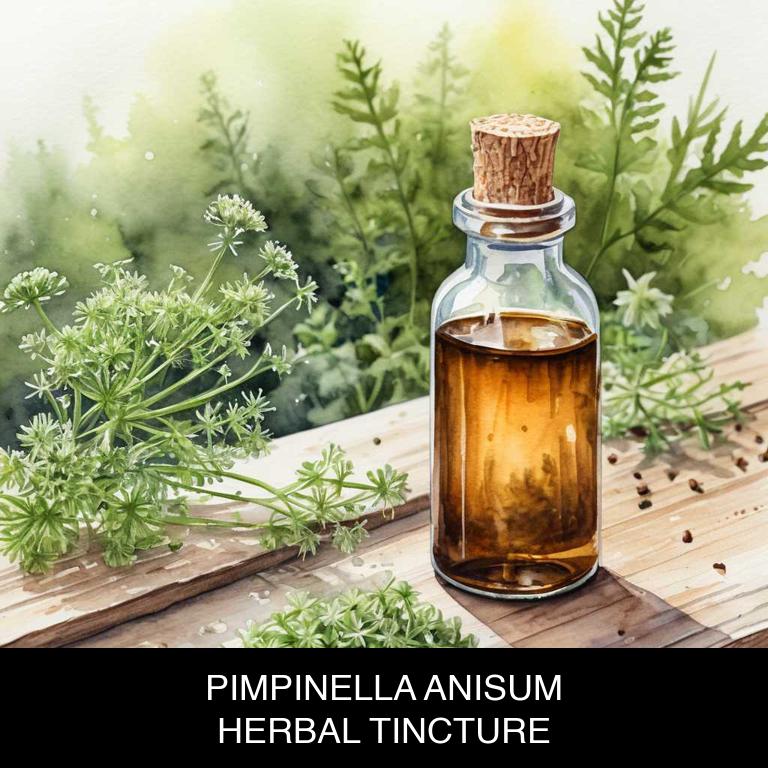
Medicinal Constituents
The list below shows the primary medicinal constituents in Pimpinella anisum tinctures that help with nausea.
- Anethole: Anethole is a phenolic terpene that helps with nausea by acting as a GABA receptor agonist, which can help reduce anxiety and alleviate nausea associated with stress and anxiety.
- Linalool: Linalool is a terpene that helps with nausea by exhibiting anti-inflammatory and antioxidant properties, which can help reduce inflammation and oxidative stress in the digestive system that contribute to nausea.
- Myristicin: Myristicin is an alkaloid that helps with nausea by acting as a 5-HT3 receptor antagonist, which can help block the action of serotonin in the digestive system and alleviate nausea associated with chemotherapy and other causes.
Parts Used
The list below shows the primary parts of anise used to make tinctures for nausea.
- Seeds: The seeds are used due to their high concentration of anethole, which has anti-inflammatory and digestive properties that help alleviate nausea.
- Leaves: The leaves are used as they contain various volatile oils, including anethole, that have a calming effect on the digestive system and help reduce nausea.
- Roots: The roots are used due to their ability to stimulate digestion and alleviate nausea, possibly due to their content of various bioactive compounds and volatile oils.
Quick Recipe
The following recipe gives a procedure to make a basic anise for nausea.
- Gather 1 part of fresh pimpinella anisum leaves and flowers and combine with 2 parts of vodka in a clean glass jar.
- Store the mixture in a cool dark place for 2 to 6 weeks to allow for infusion and extraction.
- Strain the liquid through a cheesecloth or a coffee filter into a clean glass bottle discarding the solids.
- Add a small amount of glycerin to the liquid and gently stir to help preserve the herbal extract.
- Label and date the bottle and store it in a cool dark place for up to 2 years before using.
What is the best combination of herbal tinctures to use for nausea?
The best combination of herbal tinctures that help with nausea is a blend of Ginger (Zingiber officinale), Peppermint (Mentha piperita), and Chamomile (Matricaria chamomilla).
Ginger helps to calm the stomach and alleviate nausea, while Peppermint aids in digestion and reduces inflammation. Chamomile soothes the mind and body, further reducing anxiety and discomfort associated with nausea.
This trio can be taken individually or combined in a ratio of 1:1:1 to create a natural remedy for nausea relief.
What ailments similar to nausea are treated with herbal tinctures?
Ailments similar to nausea/tinctures.html">nausea/tinctures.html">nausea that are treated with herbal tinctures are digestive issues such as bloating, cramps, and diarrhea.
Other conditions like vertigo, migraines, and stress-induced anxiety can also be alleviated with the use of herbal tinctures.
For example, peppermint oil tincture can help soothe irritable bowel syndrome (IBS) symptoms, while ginger tincture can combat nausea and vomiting associated with morning sickness or chemotherapy.